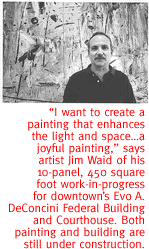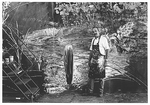
Local Painter Jim Waid's Making A Federal Case Of Public Art.
By Margaret Regan
JIM WAID IS at work on the biggest painting of his career.
In his backyard
studio in Menlo Park, 10 huge canvases lean against the austere
white walls. Waid has been working on the sprawling panels on
and off for over a year, covering them with his characteristic
loose paint strokes, gyrating plant shapes and hyped-up desert
colors.
"The actual size is almost to the scale of a human being,"
Waid said on a recent afternoon so hot that the temperature nearly
matched the yellow heat in his painted desert. "A lot of
things have to be different as I blow (the study) up."
 Each canvas measures five feet wide by nine feet high; hinged
together, they'll make a nine-foot-tall painting that stretches
50 feet long. Its 450 square feet may not sound like much if you're
talking real estate, but that's a mighty big space for acrylics
to cover. But we are talking real estate. The painting is destined
to hang in the new federal courthouse now under construction in
downtown Tucson. When it's completed next summer, the massive
Evo A. DeConcini Federal Building and Courthouse, named for the
late real-estate mogul, Arizona Supreme Court justice and father
of ex-Senator Dennis, will soar to about 140 feet, the equivalent
of 11 stories, occupy a gigantic L-shaped footprint at the corner
of West Congress Street and Granada Avenue, and will measure about
413,000 square feet.
Each canvas measures five feet wide by nine feet high; hinged
together, they'll make a nine-foot-tall painting that stretches
50 feet long. Its 450 square feet may not sound like much if you're
talking real estate, but that's a mighty big space for acrylics
to cover. But we are talking real estate. The painting is destined
to hang in the new federal courthouse now under construction in
downtown Tucson. When it's completed next summer, the massive
Evo A. DeConcini Federal Building and Courthouse, named for the
late real-estate mogul, Arizona Supreme Court justice and father
of ex-Senator Dennis, will soar to about 140 feet, the equivalent
of 11 stories, occupy a gigantic L-shaped footprint at the corner
of West Congress Street and Granada Avenue, and will measure about
413,000 square feet.
"There were an obvious number of places in the building
where the art might go," Waid said, "and one was a big
wall in the lobby of the Granada Avenue building." The painting
will be installed there, facing the Catalina Mountains to the
north, above a balcony and staircase meant to mimic the mountains'
switchbacks. (A sculpture by California artist Lita Albuquerque
will go up in a courtyard.)
Waid has done few public art commissions in his career, and he
thinks "only in the most general way" about the future
audience for the work--the judges and jurors, the guards and suspected
drug dealers. He's more concerned about aesthetic and technical
questions: How much does he need to heighten the colors, to exaggerate
perspectives, so the image works from the lobby floor as well
as from the balcony? Will the panels match up when they're in
place? Should the work be an abstracted landscape of the desert,
or a more realistic illusion of depth?
"I want to create a painting that enhances the light and
space," he said. "It's a joyful painting."
BUT IF WAID creates the beautiful work of art he intends,
it will be a happy ending, sort of, to a typically tortured Tucson
development story. The commission was awarded by the General Services
Administration, the real-estate branch of the federal government,
through its Art-in-Architecture Program. Dating back to 1963,
the program is a clear descendant of New Deal programs that had
artists painting heroic murals in post offices all across the
country. The hotly contested courthouse, an $81-million federal
project, is going up on land near Tucson's birthplace along the
once-marshy Santa Cruz River. Once prime agricultural fields,
the tract later evolved into a transportation hub, sheltering
stables and overflow activity from the old El Paso & Southwestern
Railroad. Later it was occupied by Carl Hayden Hospital, which
was razed in 1979, a decade after urban renewal that laid waste
to the surrounding barrios. Owned by developer Allan Norville,
the acreage stood empty for years.
 In the early 1990s, Norville proposed a convention hotel, exhibition
hall (particularly for the Gem & Mineral Show), offices and
retail shops for the site. But the federal government had other
plans. Property the feds already owned on East Congress, between
Stone and Scott avenues, was deemed too small and too insecure
for a federal courthouse in the wake of the Oklahoma City bombing.
Some city council members and arts types thought a location at
Stone and Alameda would be beneficial to downtown revitalization,
and they were miffed when a public hearing on the subject seemed
designed to muffle dissent.
In the early 1990s, Norville proposed a convention hotel, exhibition
hall (particularly for the Gem & Mineral Show), offices and
retail shops for the site. But the federal government had other
plans. Property the feds already owned on East Congress, between
Stone and Scott avenues, was deemed too small and too insecure
for a federal courthouse in the wake of the Oklahoma City bombing.
Some city council members and arts types thought a location at
Stone and Alameda would be beneficial to downtown revitalization,
and they were miffed when a public hearing on the subject seemed
designed to muffle dissent.
The feds were intent on four of Norville's acres for their new
building, and when he turned up his nose at their $1.93 million
offer, they condemned it. At a jury trial in early 1997 to determine
the price, federal lawyers made the not very tactful argument
that they shouldn't pay much because Tucson's desolate downtown
wasn't worth much (one lawyer talked of the city rolling up its
sidewalks at night). Local though they were, the jury sided with
the feds and gave Norville only $2.7 million. But on appeal late
last year, another jury gave Norville $8.39 million, a sum that
Tucson boosters immediately judged to be a sign of confidence
in the downtown's re-emergence.
Along the way, Don Diamond lobbied against the project, since
it will pull a bevy of rent-paying federal offices out of La Placita,
which Diamond owned at the time. The Congressional Republicans'
budget-conscious Contract with America was another threat. The
project finally prevailed, but not without engendering a lot of
hard feelings locally.
MEANTIME, WAID WAS keeping an eye on all the turmoil. "I
got the commission in the spring of '96, but the GSA told me,
'Don't order your stretchers yet, we're having a funding problem,'
" Waid remembered. "I was worried. Then I had the museum
show at TMA (Tucson Museum of Art, in November 1996) and I got
the stretcher bars when the museum show opened."
 To prepare for what may well be his summation of all that he's
tried to convey about the Sonoran Desert in his art, Waid did
a lot of hiking in Saguaro National Park West, where he sketched
and photographed, and read natural history by the likes of Gary
Paul Nabhan.
To prepare for what may well be his summation of all that he's
tried to convey about the Sonoran Desert in his art, Waid did
a lot of hiking in Saguaro National Park West, where he sketched
and photographed, and read natural history by the likes of Gary
Paul Nabhan.
"Basically, this is a desert landscape that's more or less
abstracted...I want it to have a canyon wall feeling. I'm in an
argument with myself, whether it should be a literal entering-in
kind of space. I'm not sure whether the shallow space might be
better. Right now I'm trying to push the literalness."
Waid works on as many of the panels at once as he can, usually
at least three at a time. Despite the vast size, he's adhering
to his typical working method. First he applied "dark brownish
purple over the whole thing," then did a thin white sketch,
using a brush tied to bamboo pole to get some distance from the
surface. After that, he laid in big patches of color.
"It's still relatively loosely painted," he said. "I'm
laying things in and taking things out."
Photographer David Burckhalter has documented the making of the
painting from start to finish; it may be another year before the
end is at hand. Despite three studio visits from GPA officials,
Waid said he's not overly conscious of Big Brother looking over
his shoulder.
"I couldn't have done it If I hadn't been able to do my
own style," Waid said. "The great tragedy of public
art is that artists can be forced to do things not in their general
realm...Or committees are striving to be so fair and democratic
you get everybody's second choice."
 Why do public art at all?
Why do public art at all?
"That's like asking, 'Why do art?' It's a basic impulse.
In Europe you go to look at the Sistine Chapel...Nobody's going
to come look at our architectural legacy. I'd like to see more
grandeur in our public spaces."
Once his painting is in its new public space, just a mile east
of his home, Waid said he hopes to be able to make some final
touches in situ. And after it's done, he imagines he'll
visit a lot, though he hopes he won't be like Bonnard, the French
painter found trying to touch up one of his paintings in a museum
when it was some 20 years old.
The big desert painting, of the much-loved local landscape, rendered
by one of the town's most respected artists, might be some compensation
for locals still angry about the disputed courthouse. For Waid,
at least, it's a wonder that as long as the building is there,
"the painting will be there. It feels great."

|





